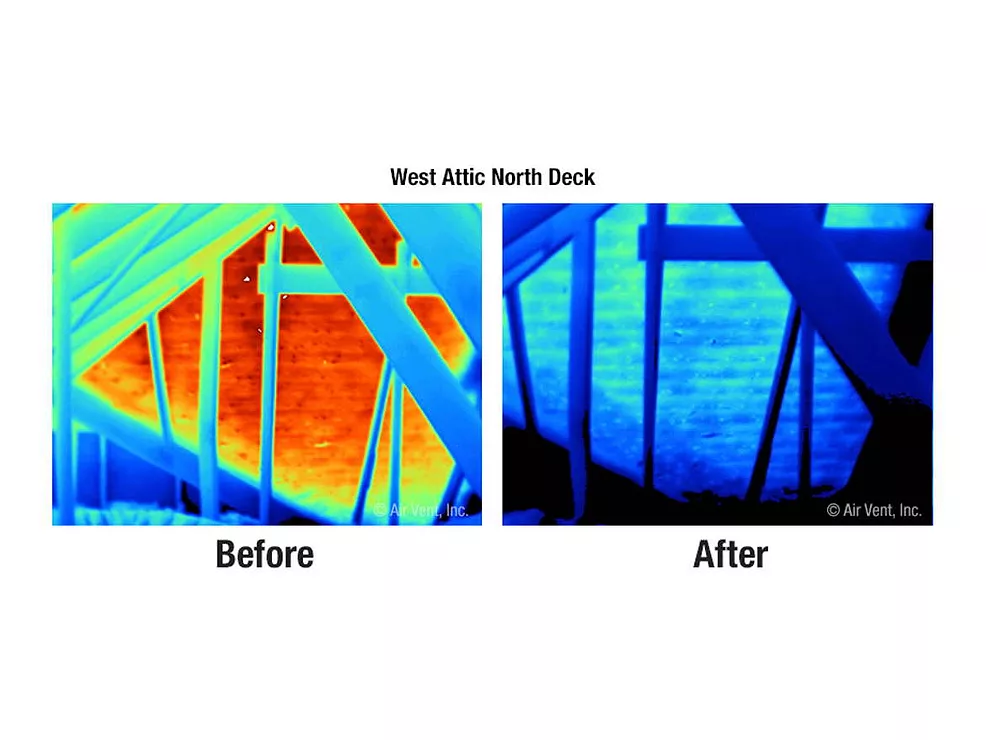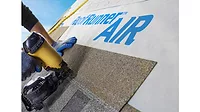Breathable Roof Underlayments
In Europe, understanding the need for buildings to breathe is a given. Products for cladding and decorating the exterior of buildings are expected to be breathable. In North America, we read literature and test reports providing evidence that we should incorporate this principle of breathability into the design of our buildings; but unfortunately, we are slow in recognizing this issue.
In North America, the most widely used underlayment is 15- and 30-pound roofing felt. In the last two decades, ice and waterproofing membranes have become the norm in situations where one anticipates ice-damming problems. Since the 1950s, humidification in buildings has become increasingly popular, which adds considerable humidity in residential, commercial and institutional structures. Older buildings simply are not equipped to handle this additional humidity. As a result, water vapor drives through the walls and ceilings and eventually condenses on insulation or other building components.
Historic buildings, in particular, are at risk because they generally lack vapor retarders. Yet with the goal of providing a secondary roofing system, these buildings are wrapped in roofing felt, or worse, ice and waterproofing membranes.
Roofing felts are marginally breathable and certainly suffer from condensation through the winter months. Ice and waterproofing membranes that are self-sealing at the joints and at nail penetrations are almost perfect vapor retarders. The designer, with the intention of providing a high-quality secondary roofing system, inadvertently produces a situation where long term performance of the building may be catastrophic.
The following are excerpts from the “Concrete and Clay Tile Roof Design Criteria Manual for Cold and Snow Regions,” published by the National Tile Roofing Manufacturers Association Inc. and the Western States Roofing Contractors Association
(produced by Leland E. Gillan and Terry Anderson). They discuss various problems with existing underlayments.
Chapter 4
Section IV. Criteria for Underlayment, Asphalt Felts or an Ice and Waterproofing Membrane
A.1. Felt underlayments are intended to protect the building from wind driven snow and rain. They are required by code. Even a good tile may allow a dry light snow to blow under it and onto the felt where melting will eventually occur.
B.1. On a well designed tile roof, the underlayment generally wears out before the tile. Two layers of ASTM D226, Type II, No. 30 asphaltic felt overlaid in shingle fashion is the recommended minimum.
C.1. Asphaltic felt deterioration is caused in various ways.
C.1.1. Exposure to the sun’s ultraviolet rays deteriorates the felt’s surface very quickly. This exposure often takes place after the roof felt has been installed but not yet covered with tiles. In some cases, months have passed before the felts are covered with tile.
C.1.2 Water running over or, much worse, ponding on the felts removes the asphalt’s oils. Dirt collecting on the felts behind horizontal batten boards placed directly on the felts will hold water. This will keep felts moist for extended periods of time, causing rapid deterioration. Placing vertical batten boards (i.e. counter battens) below the horizontal batten boards that hold the tile allows water to drain off the felts quickly and helps prevent dirt accumulation.
C.1.3. As the asphalt oxidizes from exposure to air, it becomes brittle. This is okay on a roof as long as it is not exposed to sunlight or handled since the old brittle asphalt felt will rip very easily.
D.1. While an adhered waterproofing membrane may not be required in valleys and along eaves, it can be a cost-effective valuable addition to prolong the life of the roof.
E.1. Caution: A roof completely covered in a waterproofing membrane, sometimes with asphaltic felts, and either an inadequate vapor retarder or no vapor retarder with no venting, may prevent adequate vapor removal from the attic or rafter joist space. Apparent roof leaks that are actually the accumulation of condensation may develop. See Figure 4-17, 4-18.
Appendix B-1
VentilationSection II. Controlling Vapor Drive
A.1. Vapor drive must be controlled so that there is less moisture allowed into a ceiling or wall than can be removed to the outside. Often people refer to a vapor barrier when they are really talking about a vapor retarder; there are very few building systems that create a true vapor barrier. Materials such as gypsum board and most paints used on building interiors provide almost no vapor retardation.
A.1.1 An example of a problem roof seen often in mountain areas is where an ice and waterproofing membrane is used on the roof deck directly above an insulated roof system with no attic, a 4-mil thick polyethylene sheet vapor retarder on the inside or warm side, and gypsum board. No ventilation is provided in the joist space. The vapor drive forces moisture through the staple holes, nail holes and screw holes and lap joints of the polyethylene and into the interior ceiling. The moisture is not allowed to move to the outside as fast as it comes in because of the ice and waterproofing membrane placed on top of the roof which seals itself when nails are driven through it. Moisture content in wood of over 20 percent will allow most woods to start rotting. In a few years a roof joist can rot to the point of collapsing.
B.1. In all buildings in cold climates the vapor retarder must be better on the inside of the building than on the outside or have sufficient vents.
Solutions
Having established that there are problems with the underlayments that are presently in use, it is worthwhile to consider the performance of hard roofing products in the marketplace. High quality slate and clay tile roofs have produced life expectancies in North America approaching, and in some cases exceeding, 100 years. Modern conventional roofing felts have nowhere near this life expectancy. Roofing felts begin to deteriorate immediately when exposed to sunlight or moisture (in the form of rain or condensation) (ARMA/NRCA Research Report on the Performance of Asphalt-Saturated Underlayment Felts).Superior coated polypropylene products are now available that are strong as well as tear-, rot- and UV-resistant. These membranes perform reasonably well as temporary roofs and can be expected to exhibit long-term performance once protected from UV by the slate or tile. In terms of breathability, they are similar to 30-pound roofing felt.
Most ice and waterproofing membranes have good life expectancies once they are protected from UV. They remain, by far, the best solution to dealing with ice damming conditions. Installation of these products is required at the eaves, valleys and other areas where significant snow accumulations occur.
There now exists another category of underlayments (breather membranes) that are extremely breathable and durable. The best of these have moisture vapor permeability in the range of 2,400 grams per square meter per day, which is approximately 64 gallons per 10.76 square feet per day. This is a magnitude of more than 200 times more breathable than 30-pound felt or coated polypropylene membranes. These breather membranes are waterproof, tear-, rot- and UV-resistant. They are not self-sealing underlayments and are installed in a similar fashion as 30-pound roofing felt.
A superior version of the breather membranes is an uncoated spun-bonded polypropylene three-ply membrane. This product can be exposed to UV radiation for months without deterioration and therefore can perform as a temporary roof. Fewer nails are required for securement because the product is tear-resistant and very strong. Cap nails further reduce securement requirements. Roll sizes are available in 59 inches by 164 feet or 118 inches by 164 feet, which allows for reduced labor time in installation. Considering the life cycle of slate and tile roofs, it is essential to employ an underlayment that will be as durable.
In the UK, “Daltex Roofshield” has been awarded a British Board of Agrément Certificate for cold roof design. The benefits are: no additional risk of condensation, no requirements for eave and ridge venting, a warmer roof space, increased efficiency of insulation, easy installation, easier site supervision and simpler specifications.
There is also an argument for breather membranes for cedar shingle roofs and cedar shake roofs. These membranes can be used as underlayment and as interlayment. It has long been believed that cedar roofs perform better if they are able to dry out.
Both traditional and modern metal roofing systems are well suited for breather membranes. Traditional metal roofs suffer from condensation generally at the level of the felt underlayment or the slip sheet. A breather membrane can act as both a waterproof secondary roof and a slip sheet. Modern composite metal roofs suffer from internal condensation that can eventually compromise the insulation and even possibly the securement. Breather membranes allow water vapor to escape by condensing on the underside of the metal roof, dripping back onto the underlayment and draining to the eave.
In North America, we struggle to provide adequate ventilation in roof spaces. Often it is difficult, because of building design, to introduce enough vents and place them where they will be effective. Wherever breather membranes are installed, they will reduce the possibility of condensation forming and help protect structures.
Breather membranes have already found their way onto numerous historical buildings of significance in both Canada and the United States. Modern composite metal roofing systems such as the Detroit Metro Airport benefit by using a breather membrane to protect the integrity of the rigid insulation.
The principle of breather membranes will not only impact the roofing industry in North America, but also will quite possibly play a growing roll in building envelope design.
Looking for a reprint of this article?
From high-res PDFs to custom plaques, order your copy today!




